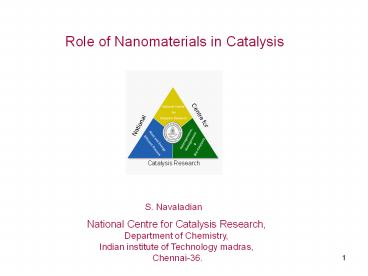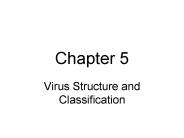A1258150468aPpTr - PowerPoint PPT Presentation
1 / 32
Title:
A1258150468aPpTr
Description:
Advancement in the electron microscopic microscopic techniques ... (C) Marks decahedron and (D) cuboctahedron. Shape of fcc gold 5 nm. 10. Spherical iron ... – PowerPoint PPT presentation
Number of Views:388
Avg rating:3.0/5.0
Title: A1258150468aPpTr
1
Role of Nanomaterials in Catalysis
S. Navaladian
National Centre for Catalysis Research,
Department of Chemistry, Indian institute of
Technology madras, Chennai-36.
2
Introduction
Nanomaterials
Materials of size in the range of nm .i. e., 10-9
m
Nanomaterials are well known in catalysis atom
economy
What is new then? Advancement in the electron
microscopic microscopic techniques
Good example Supported Gold nanoparticles of
size (lt 5 nm) for CO oxidation
3
CO oxidation
I, Au/?-Fe2O3 (Au/Fe l/19, coprecipitation,
400C) (2) 0.5 wt Pd-?-Al2O3J (impregnation,
300C) 3. Au fine powder 4, Co3O4 (carbonate,
400C) 5, NiO (hydrate, 200C) 6, Cu-Fe2O3
(hydrate. 400C) 7. 5 wt Au/a-Fe2O3
(impregnation, 200C) 8). 5 wt Au
/?-Al2O3J (impregnation. 200C).
Haruta et al., Chemistry Letters, (1987) 405
4
H2 Oxidation
I, Au/?-Fe2O3 (Au/Fe l/19, coprecipitation,
400C) (2) 0.5 wt Pd-?-Al2O3J (impregnation,
300C) 3. Au fine powder 4, Co3O4 (carbonate,
400C) 5, NiO (hydrate, 200C) 6, Cu-Fe2O3
(hydrate. 400C) 7. 5 wt Au/a-Fe2O3
(impregnation, 200C) 8). 5 wt Au
-?-Al2O3J (impregnation. 200C).
Haruta et al., Journal of Catalysis, 115(1989)301
5
CO oxidation on various Au/ metal oxide supports
Open symbols reducible Supports Closed symbols
Non-reducible supports
B. Hvolbaeka, and K. Nørskov, Nanotoday, 2 (2007)
14.
6
What happens when size decreases?
- Surface area increases
- Co-ordination number of atom decreases (more no
of exposed atoms) - Band gap redox potentials HOMO-LUMO gap
altered-reactivity varies - Melting point variation
- Enhanced toughness
- Magnetic properties
- Unuasual crystal structures
- Surface plasmon resonance in metals
- Surface enhancement in Raman spectrum
- Morphological effect
7
Surface area dependence on particle size
(n- Number of atoms per particle)
G. Bond and D. T. Thompson, Catalysis Reviews, 41
(1999) 319
8
Melting point Vs Particle size
Melting point decreases dramatically as the
particle size gets below 5 nm
9
Unusual structures
Shape of fcc gold lt 5 nm
- truncated octahedron, (B) icosahedron,
- (C) Marks decahedron and (D) cuboctahedron
10
Surfece to bulk ratio with size
Spherical iron nanocrystals
Journal of Physical Chemistry, 100(1996)12142
11
Surface to volume ratio
Source Nanoscale Materials in Chemistry, Wiley,
2001
12
Pd
M 309
M 561
M 55
PtFe
13
Origin of the Properties
Bulk Metal
Nanoscale metal
Decreasing the size
Unoccupied states
occupied states
Separation between the valence and conduction
bands
Close lying bands
Unbound electrons have motion that is not confined
Electron motion becomes confined, and
quantization sets in
14
Energy Diagrams of Semiconductor
NANOPARTICLE
Energy
15
Magnetic properties
- Bulk Al metal is diamagnetic Al clusters (13
atoms- 0.8 nm) is magnetic. - due to the change in the electronic
configuration. - Pd and Pt bulk is not magnetic, but
nanoparticles are ferromagnetic. Due to - the structural changes associated with size.
- PtFe alloy particles ( 30 -100 nm) are showing
higher coercively. - Both Au and Au NPs are non-magnetic poor
density of states. - Au NPs capped with thiols are magnetic due to
eth alteration of d band structure - Large spin-orbit coupling of noble metal leads
to anisotropy in the crystals leading - to the high ordering of spin.
Enhanced strength and toughness
- Due to the defects present in the nanoparticles
mainly dislocations
16
Band diagram of CdTe nanocrystals
UV-visible spectra
CdTe nanocrystals
CdSe nanocrystals
17
Colour change with particle size
Quantum dots are semiconductors particles that
has all three dimensions confined to the 1-100 nm
length scale
Colloidal CdSe quantum dots dispersed in hexane
Size decreasing
18
Nanomaterials with various morphology
19
Density of states of nanoparticles with different
morphology
A. P. Alivisatos et al., Journal of Physical
Chemistry,100 (1996) 13226
20
Band structure with various morphology
A. P. Alivisatos et al., Journal of Physical
Chemistry,100 (1996) 13226
21
The dissociative chemisorption energies for
oxygen DFT calculation
bcc (210) surface ( Fe, MO, W)
fcc (211) surface For other metals
Only gold shows endothermic chemisorption- highly
inert for oxygen
Au has d-states so low in energy that the
interaction with oxygen 2p states is net
repulsive.
Hvolbaek et al., Nanotoday, 2 (2007)14
22
DFT calculation for two pathways of CO oxidation
favorable
Hvolbaek et al., Nanotoday, 2 (2007)14
23
DFT calculation of binding energies
Binding energy is low for low co-ordination of
Au. Hence CO oxidation is facile even at low
temperatures
Hvolbaek et al., Nanotoday, 2 (2007)14
24
Particle size and co-ordination number
- Active sites are corner atoms
- Below 5 nm of size CO oxidation activity is
drastically increases - Corner and edge atoms increasing. Flat surface
are remaining same - and decreasing
Hvolbaek et al., Nanotoday, 2 (2007)14
25
- Why Au nanoparticles are active?
- Low co-ordination number. Atoms in the corner
are - active sites
- Defect site promoted catalytic effect
- Strong metal-support interaction (SMSI) on
reducible supports like TiO2, Fe2O3. But,
unsupported Au NPs is also active?.
26
Unsupported Au is also active? yes
CO oxidation a-gold
Dealloying of Ag/Au alloy
After reaction
6 nm pores
25 nm pores
Likewise corner atoms may contribute for the
catalytic activity of Au NPs
Xu et al.,Journal of the American Chemical
Society, 129 (2007) 42-43
27
Work function and Fermi level in solids
Work function of Ag Ag 4.26 eV Ag(100)
4.64 eV, Ag(110) 4.52 eV Ag(111) 4.74 eV
Also depends upon packing of The metals bcc
low work function fcc hcp high work function
W - Work function U - potential well EF Fermi
energy
28
Important criterion for catalytic activity of
metals
- Position of centre of the d-band
- Shape and width of the d-electron density
- High d-electron density Fermi level is a factor
indicating - the catalytic activity
- Example Pt a versatile catalyst
T. Bligaard et al., Electrochimica Acta, 52
(2007) 55125516
29
Calculated d-projected densities of states for
different Pt surfaces
Co ordination decreases
A shift of ?d by 1 eV takes place
Catalytically more active- Favorable CO
adsorption
Atomic density decreases
Bandwidth depends on the coordination number of
the metal and this leads to substantial
variations in the d-band centers
T. Bligaard et al., Electrochimica Acta, 52
(2007) 55125516
30
UPS spectra of Pt and Pt alloys
d band is closer to the Fermi level
Stamenkovic et al., Nature materials, 6 (2007)241
31
UPS spectra of Au, Ag and Cu
Ag
Cu
Au
32
Concluding remarks
- The abnormal catalytic activity of Au NPs is
attributed to - the various factors such as low
co-ordination of Au atoms, - defect sites and metal-support interactions.
- The increase in the atoms with low
co-ordination number shifts - the d-band DOS to towards the Fermi level
and changes the - shape and width of the d-band in transition
metals. - But still clear-cut reasons are not available.
This may go a long - way in explaining the catalytic activity of
nanomaterials.
Thank you































